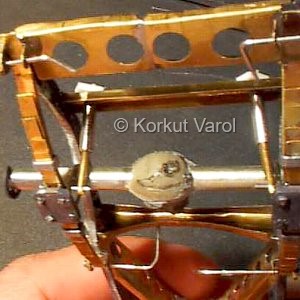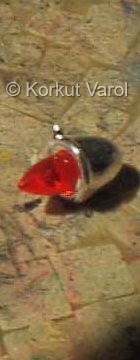| The bottom boot panel was now put
into
place and glued with 5-minute epoxy. The two pictures show the panel
from
the bottom and from the top. |

|
 |
| The protruding contour of the body
was
given by glueing a 0.5 mm dia. copper wire on the body. |

|
| To make the profile transition
smooth,
automotive polyester putty was applied along. |

|
| The body parts were sanded down
smooth
for the first primer coat to be applied. |

|
| The front grille was maked with
masking
tape, then the first primer coat was applied. Automotive filler primer
( cellulosic based ) was used for the purpose. Remember that, if you
apply
cellulosic based primers or filling elements, then you can apply either
synthetic or cellulosic based coats on. However, if the primer elements
are synthetic based, then you will be limited to synthetic coats
only. |

|
| The irregularities were seen after
the
primer and putty was applied on. This examining and smoothing out
operations
went on for a couple of times, taking about one week. |

|
| Back to the rear suspension again.
The
lower mounts of the rear shock absorbers were made by inserting two
pins
cut to 8 mm length between the rubber block and the U-bolts. The pins
were
secured by applying 5-minute epoxy around them. |

|
| For the upper mount of the shock
absorbers,
a new cross-member was made for the chassis. Two holes 1 mm dia. wewre
drilled on the cross-member at a convenient position so that the shocks
would go straight between the the two mounts without interfering with
anything.
The positioning of the cross-member was made with the same criterion. |

|
| The shock absorbers were prepared.
The
upper parts were cut from ball-point pen refills. Pins cut to 3 mm
length
were glued with CA glue to their top. They were to go through the two
holes
on the recently made cross-member. The lower parts were made from 1.5
mm
dia. brass wire. The ends were flattened with light hammering, then
holes
of 1 mm. dia. were drilled on the flattened portions. Then these parts
were machined to have a proper look. Next, a temporary assembly was
made
for testing purpose. |
 ... ...
|
| The rear skirt profile was too
sharply
finishing in the air, so it had to be smoothened. For the purpose, a
toothpick
was used and stuck to the body by 5-minute epoxy. |

|
| Then automotive polyester putty was
applied
over the toothpick and then sanded down to shape. Two holes of 1 mm.
diameter
were drilled for inserting the support bars of the rear lamps. The rear
lamps were formed from the parts box. The body was once the mirror of
some
model. Lucky that they had given twin mirrors! |
 
|
| Aluminium acrylic base paint was
applied
on all the parts. The car is going to be amber. Clear amber will be
applied
over this aluminium base coat.However, it will be applied later, when
all
the necessary and excessive handling of the body parts are over for
manufacturing
tailored parts for the car. |

|

|
 
|

